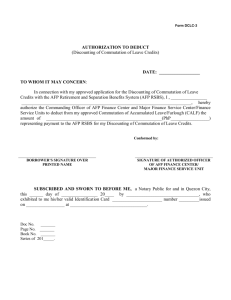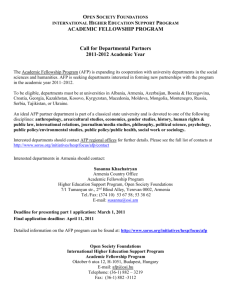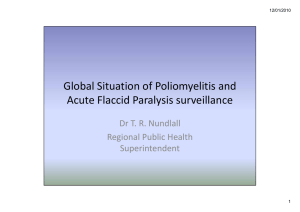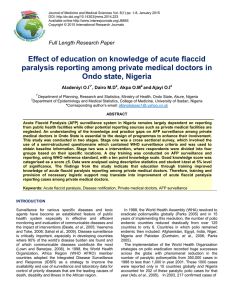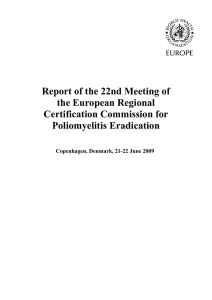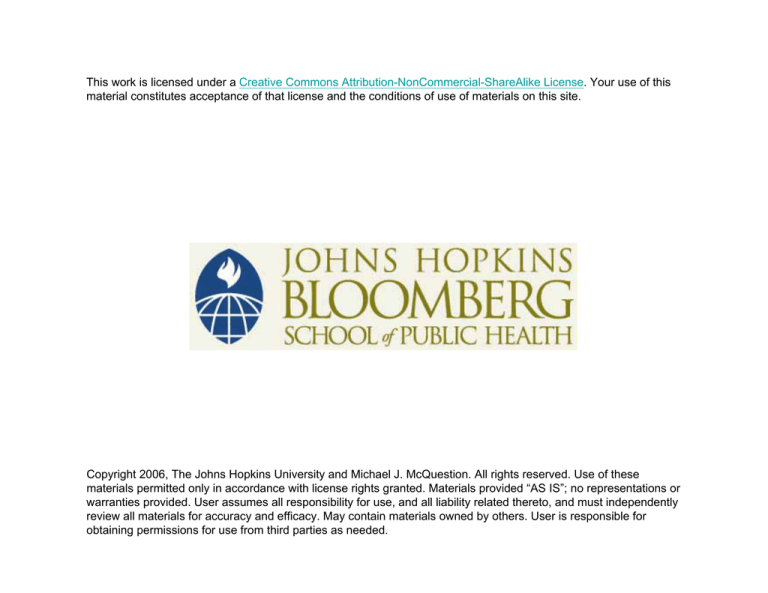
This work is licensed under a Creative Commons Attribution-NonCommercial-ShareAlike License. Your use of this
material constitutes acceptance of that license and the conditions of use of materials on this site.
Copyright 2006, The Johns Hopkins University and Michael J. McQuestion. All rights reserved. Use of these
materials permitted only in accordance with license rights granted. Materials provided “AS IS”; no representations or
warranties provided. User assumes all responsibility for use, and all liability related thereto, and must independently
review all materials for accuracy and efficacy. May contain materials owned by others. User is responsible for
obtaining permissions for use from third parties as needed.
Eradication, Part 1: Polio
Michael J. McQuestion, PhD, MPH
Johns Hopkins University
This lecture contains materials prepared by Ciro A. de Quadros. Used with permission.
Section D
Polio Update
Polio Progress Report
2000
− 82% of infants worldwide received three doses
of oral polio vaccine (OPV)
2001 and 2002
− The figure declined to 75%
2003
− 55 countries conducted Supplementary
Immunization Activities (SIAs), reaching 415
million children
Continued
3
Polio Progress Report
All countries presently and previously endemic for
polio have active Acute Flaccid Paralysis (AFP)
surveillance systems
Globally, the AFP rate was 1.9 per 100,000
persons ages <15 years at the end of 2003
This compares to an expected background rate of
1 per 100,000
Proportion of suspected cases with adequate stool
specimens was 86%
4
Case Study: AFP Surveillance in Africa
African Region countries introduced active AFP
surveillance in 1995
By 1999, 38 countries were regularly reporting AFP
and other polio surveillance data to WHO
Countries adopted an Integrated Disease
Surveillance and Response strategy, centralizing
and coordinating core surveillance activities for
polio, AFP, and other communicable diseases
Continued
5
Case Study: AFP Surveillance in Africa
Core surveillance activities
− Case detection, registration, confirmation
− Reporting, analysis, use, and feedback of data
− Epidemic preparedness and response
Other diseases included measles, neonatal
tetanus, yellow fever, meningitis, cholera
6
Case Study: Findings
Nsubuga et al (2002) surveyed key informants in
32/38 participating countries to assess the
integrated system
Findings
− 31/32 countries had designated AFP
surveillance officers (median 10/country)
− 27/32 countries reported median annual AFP
surveillance budget of $US 125,000
− 26/32 countries had at least one vehicle
designated for AFP surveillance
Continued
7
Case Study: Findings
Surveillance Integration Indicators, 32 African Countries 2000
Attribute
Use AFP resources for surveillance of ot her diseases
n
26
(%)
(81)
Combine detecti on of other diseases with AFP
Inform clinicians about ot her diseases when informing
about AFP
28
(90)
27
(87)
Use AFP lab transport system for ot her diseases
Total
14
32
(44)
Source: Nsubuga et al 2002
Continued
8
Case Study: Findings
Findings
− 15/32 countries had attained AFP surveillance
system sensitivity above the benchmark (nonpolio AFP rate=1/100,000 children aged <15
yrs)
− 11/15 adequate performing countries had
added 2–5 other diseases to their AFP
surveillance programs
Conclusion
− Integration is feasible without adversely
affecting AFP surveillance
9
Polio Progress Report
At the end of 2003, there were 682 polio cases
reported from six countries
− Afghanistan
− Egypt
− India (220 cases)
− Niger
− Nigeria (305 cases)
− Pakistan (99 cases)
10
Recrudescence
Rumors and resistance led to cessation of polio
vaccination in Northern Nigeria in mid 2003
Result: poliovirus spread to 31/37 Nigerian states
and to 12 other previously polio-free African
countries
Coverage in those countries was not high enough
to prevent transmission
355 new polio cases in Nigeria in 2003
Continued
11
Recrudescence
Additional cost of control activities in the 10
affected African countries: $25 million
Current goal: interrupt wild poliovirus transmission
worldwide by the end of 2004
Risks
− Surveillance and house-to-house “mop-up”
vaccination efforts will lapse
− The two remaining endemic countries (Niger,
Nigeria) will not reach 90% coverage
12
Polio Progress Report
Virus-Confirmed Polio Cases
Africa
Nigeria
Nigeria
East Mediterrane an
Pakistan
Afghanistan
Egypt
South -East Asia
India
American
European
West Pacific
Worldwide
* as of May 18, 2004
2003 2004
446
162
355
133
41
12
113
15
103
12
8
2
1
1
225
8
225
8
0
0
0
0
0
0
784
185
13
Endgame
23 Western and Central African countries will hold
synchronized national immunization days in Fall,
2004, and early 2005 in a bid to end polio
transmission on the continent
Once transmission is interrupted, experts will
decide on the best strategy to stop the use of OPV
so that no vaccine-derived polioviruses will be
circulating
14


